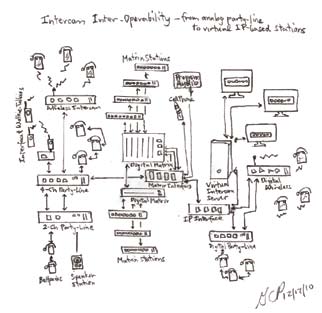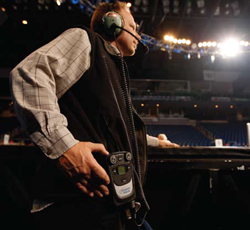Though the standard analog party-line beltpack-and-headset intercom is alive and well in thousands of venues worldwide, technology has continued to advance with the availability of faster processors, robust VOIP algorithms, DSP, networking, and other computer and telecommunications techniques.
Going beyond the large digital matrix intercom card frames and stations used almost exclusively in television broadcast applications just a few years ago, multi-channel digital matrix intercoms in 1 RU and 2 RU chassis are now readily available and can be found at the core of some live show and touring communications networks.
The transition to digital is now underway in wireless intercoms – allowing more flexible point-to-point as well as party-line communications on more than one channel without being tied to a cable.
Digital wired party-line systems are now offered, with two or more channels per user and the ability for each user to choose and switch among various party-line or point-to-point conversations at the beltpack.
Virtual intercoms have also become a reality, where a laptop or desktop computer can become a fully functional multi-channel intercom station, with party-lines, point-to-point links, and program monitoring at the click of a mouse – plus the ability via IP connectivity to bring remote individuals and teams into the same production communications in real time.

All of these devices can be interfaced together, so a matrix or virtual intercom core can seamlessly add digital party-line and wireless for a flexible communications network that meet the needs of director through stage tech. Let’s have a look at available intercom technologies.
Analog Party-Line
A traditional analog party-line system consists of beltpack or rack-mount intercom stations and a system power supply, with the components connected by 2-conductor, shielded microphone cable.
All of the users on a channel – those connected directly with each other by microphone cable – can talk and listen to each other as a group.
Multi-channel “director” stations allow the user to talk and listen on different channels, separately or at the same time. In a performance event, one channel might be for lighting, and others for props, backstage tech, and audio.
The intercom stations are powered by a DC electrical current flowing through the cabling. Each station contains a microphone preamplifier and a power amplifier for the headset or speaker.
The two-way audio signal flows through the cable as well, and the circuitry in the stations allows each user to hear everything on the channel except for his own voice. (A slight amount of the user’s voice, called sidetone, is retained so the user knows the unit is working).
Party-line systems provide relatively easy setup, simple operation, use of common cabling (standard microphone cables), portability, and clear and reliable communications. Analog party-line systems also have the lowest cost per user.
In many productions, the communications demands are not complex, and a conventional party-line system is sufficient. Most users typically converse on one or two channels, receiving cues from the directors and talking within their own group.
The directors talk with the various groups (channels) individually or together, and there may be an additional channel for directors and producers only.
Party-line intercoms are standard equipment at performing facilities, theatrical and touring lighting, auditoriums and other venues.















